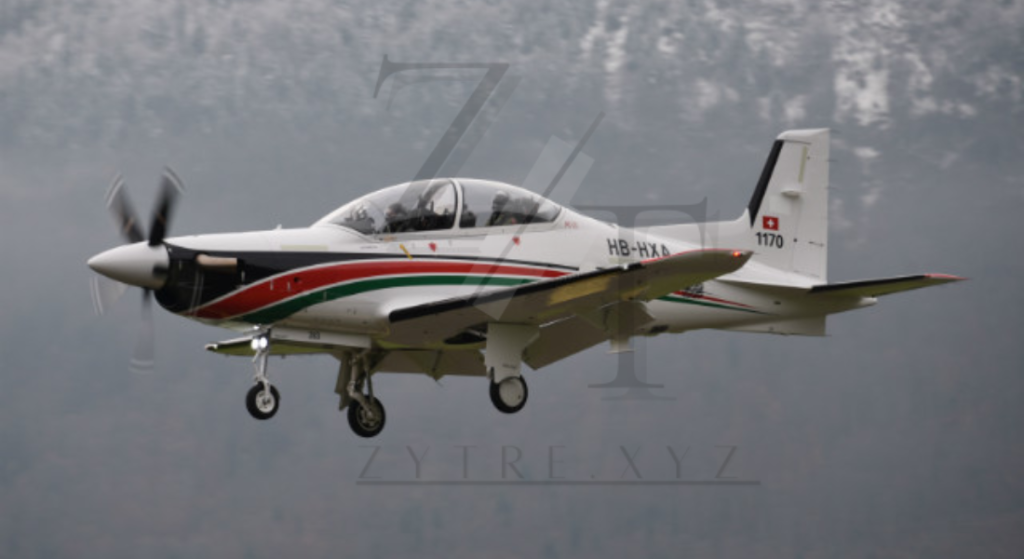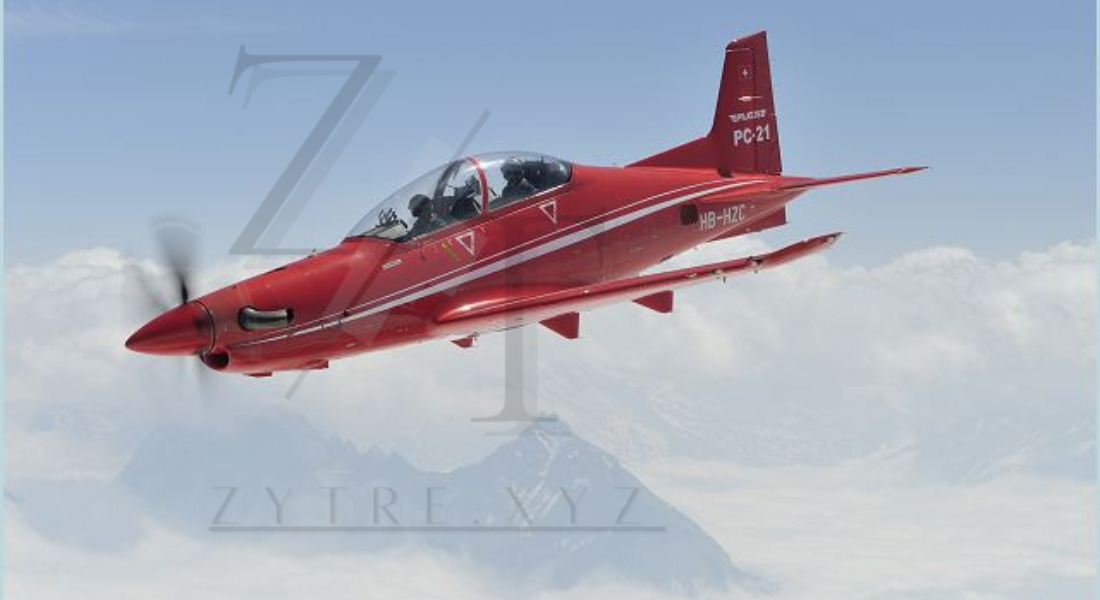In the world of aviation, training is the cornerstone of every successful pilot’s career. Whether you’re preparing for a military career, becoming a commercial airline pilot, or gaining valuable flight hours as a private aviator, the quality of your training aircraft plays a pivotal role in shaping your skills and capabilities. Enter the Pilatus PC-21 Trainer, a modern marvel that redefines the way pilots are trained.
The Pilatus PC-21 Trainer is an advanced training aircraft that has earned its place as a top choice for air forces and flight schools worldwide. Designed by the Swiss aerospace company Pilatus Aircraft, the PC-21 combines cutting-edge technology, superior performance, and an unparalleled training experience. It is a versatile and highly efficient aircraft that allows trainees to experience the most realistic flight simulation, preparing them for real-world military and civilian aviation challenges.
In this article, we’ll delve into the features, performance, and capabilities of the Pilatus PC-21 Trainer, and explore why it has become the go-to choice for both military and civilian flight training programs across the globe.
The Legacy of Pilatus Aircraft
Pilatus Aircraft is known for designing and manufacturing some of the most reliable and high-performance aircraft in the world. Established in 1939 and based in Switzerland, the company has a long-standing reputation for creating aircraft that combine Swiss precision, safety, and advanced technology. While Pilatus is renowned for its versatility and commitment to innovation, the Pilatus PC-21 represents a breakthrough in the way pilots are trained.
Unlike traditional training aircraft, the PC-21 Trainer is designed to bridge the gap between basic flight training and operational military aircraft, allowing trainees to progress seamlessly from initial flight training to advanced tactical missions. It’s a platform that simulates the characteristics of high-performance military jets while still being cost-effective to operate.
Performance and Power: The Heart of the Pilatus PC-21 Trainer
At the core of the Pilatus PC-21 Trainer lies its exceptional performance, which makes it one of the most advanced training aircraft in its class. Built with a turboprop engine and designed to simulate the handling and response of jet-powered aircraft, the PC-21 offers a unique training experience for its pilots. Let’s take a closer look at the key performance features that set the PC-21 Trainer apart.
1. Engine and Speed
The Pilatus PC-21 Trainer is powered by a Pratt & Whitney PT6A-68B turboprop engine, which provides 1,600 shaft horsepower (shp). This engine delivers remarkable power and efficiency, allowing the PC-21 to achieve a maximum speed of 370 knots (approximately 690 km/h or 429 mph).
This speed is particularly important for training pilots, as it allows them to experience high-performance flight without the costs associated with jet aircraft. The PC-21 is one of the fastest turboprop trainers in the world, making it ideal for replicating the speed and maneuverability of military jets. It’s capable of reaching altitudes of up to 35,000 feet, which gives pilots the opportunity to train at various altitudes and simulate a wide range of flying scenarios.
2. Climb Rate and Efficiency
The Pilatus PC-21 has a climb rate of 4,000 feet per minute, which is remarkable for a turboprop aircraft. This climb rate ensures that trainees can quickly reach their designated flight altitude, minimizing time spent during the climb and optimizing the training experience. The aircraft’s impressive climb rate also allows for more time spent on tactical maneuvers, improving the overall value of each flight training session.
The PC-21 is highly fuel-efficient for an aircraft of its class, offering both cost savings and the ability to perform extended flight hours during training missions. This is particularly beneficial for military organizations and flight schools looking to maximize training budgets while still offering cutting-edge flight experiences for their trainees.
3. Agility and Maneuverability
Designed to simulate the characteristics of a high-performance jet, the PC-21 Trainer offers excellent agility and maneuverability. The aircraft can perform complex aerobatic maneuvers, such as barrel rolls, loops, and high-G turns, allowing trainees to experience the same forces they would encounter in a jet. These capabilities are critical for preparing future pilots for the demands of military and civilian flight operations.
The PC-21 has a maximum G-load of +8/-4 Gs, meaning it can handle the stress of tight turns, high-speed dives, and rapid ascents. For military pilots, this is crucial training, as fighter jets typically operate in high-G environments. The PC-21 helps build the physical endurance and mental toughness required to withstand these forces.
Advanced Cockpit and Avionics: Preparing Pilots for the Future
One of the standout features of the Pilatus PC-21 Trainer is its advanced glass cockpit and avionics suite, which offer an immersive and modern training environment. The PC-21 is equipped with a digital avionics system that mimics the systems found in modern military jets, providing trainees with valuable hands-on experience with high-tech instrumentation.
1. Glass Cockpit with Multifunction Displays
The PC-21 features a fully integrated glass cockpit, with multi-function displays (MFDs) and digital flight instruments that provide real-time information about the aircraft’s performance, navigation, and mission status. The cockpit layout is designed to mirror that of operational military aircraft, ensuring that trainees become familiar with the technology they will use in advanced training and operational flights.
The cockpit includes primary flight displays (PFDs) and multi-functional displays (MFDs), offering clear visualizations of critical flight data, including airspeed, altitude, heading, and engine performance. The design of the cockpit is highly intuitive, making it easy for new pilots to quickly adapt to the digital systems.
2. Synthetic Training System (STS)
A key feature of the Pilatus PC-21 Trainer is its Synthetic Training System (STS), which allows pilots to train in realistic virtual environments. The STS includes a flight simulation that provides visual representations of various operational scenarios, including simulated combat missions, emergency situations, and weather patterns. This virtual training capability ensures that pilots can train in diverse conditions and prepares them for a wide range of flight challenges.
3. Heads-Up Display (HUD) and Simulated Combat Systems
For more advanced training scenarios, the PC-21 Trainer can be equipped with a heads-up display (HUD), a feature commonly found in modern fighter jets. The HUD allows pilots to view important flight data without taking their eyes off the horizon, improving situational awareness during high-speed maneuvers or complex missions.
The PC-21 can also be fitted with simulated combat systems, which allow trainees to practice aerial combat and tactical maneuvers in a controlled environment. This is particularly valuable for air forces that need to prepare pilots for combat scenarios without the need for actual combat.
Superior Training Capabilities: A Versatile Aircraft for Military and Civilian Use
The Pilatus PC-21 Trainer is designed to meet the needs of both military and civilian training programs. It offers the flexibility to be used for a wide range of training purposes, from basic flight training to advanced tactical and combat training.
1. Military Training Applications
The PC-21 Trainer is used extensively by air forces around the world to train military pilots. Its ability to replicate the performance characteristics of modern fighter jets makes it an excellent platform for building skills required in high-speed tactical flying. The aircraft can be used to train pilots in a variety of essential skills, including:
- Basic flight training
- Formation flying
- Tactical maneuvers
- Combat training
- Weapons delivery simulations
Air forces that use the PC-21 have found it to be a highly effective and cost-efficient alternative to traditional jet trainers, providing an ideal stepping stone for pilots transitioning to more advanced fighter aircraft.

2. Civilian Training Applications
In addition to its military applications, the PC-21 is also used by civilian flight schools to train pilots for commercial aviation. The PC-21 Trainer offers a unique advantage for civilian flight schools because it provides a jet-like experience in a turboprop trainer, making it a perfect bridge between basic flight training and more advanced commercial aircraft. The PC-21 helps pilots build their skills in real-world scenarios while simulating the handling and response of commercial airliners.
The Future of Flight Training: Why Choose the Pilatus PC-21 Trainer?
The Pilatus PC-21 Trainer is undeniably one of the most advanced and versatile training aircraft available today. Whether for military or civilian training, the PC-21 offers exceptional performance, advanced avionics, and realistic training capabilities that prepare pilots for the challenges they will face in real-world aviation. Here’s why the Pilatus PC-21 is the aircraft of choice for flight schools and air forces around the world:
1. Advanced Performance
With its powerful engine, exceptional speed, and high maneuverability, the PC-21 offers a performance level that rivals modern military jets, making it perfect for training in complex flight maneuvers.
2. Cutting-Edge Technology
Equipped with a state-of-the-art glass cockpit, advanced avionics, and synthetic training systems, the PC-21 Trainer offers a modern and immersive training environment for pilots.
3. Cost-Effective Training
The PC-21 provides the advanced capabilities of a jet aircraft while being more affordable to operate than actual military jets, making it a cost-effective choice for both military and civilian flight training.
4. Versatility for All Training Needs
Whether you’re preparing for a military career or a commercial aviation job, the PC-21 Trainer provides the ideal platform for developing the skills required for success in modern aviation.
Conclusion: The Pilatus PC-21 Trainer Sets the Standard for Advanced Pilot Training
The Pilatus PC-21 Trainer is a revolutionary aircraft that has changed the way pilots are trained. With its unmatched performance, cutting-edge avionics, and advanced training systems, the PC-21 is truly the ultimate choice for training the next generation of pilots. Its combination of speed, agility, and cost-effectiveness makes it the aircraft of choice for military air forces, civilian flight schools, and aviation organizations worldwide. Whether you’re a future military pilot or preparing for a career in commercial aviation, the PC-21 Trainer offers the ultimate training platform for success in the skies.
